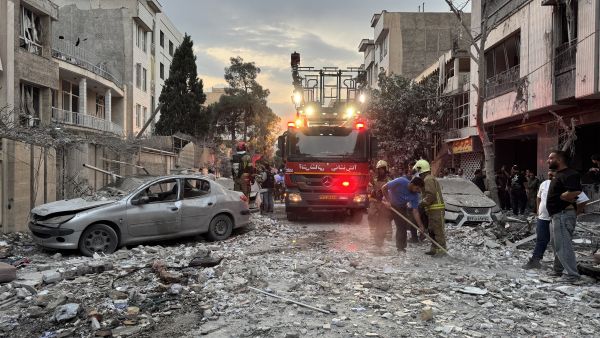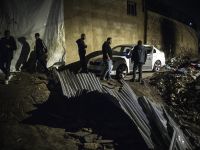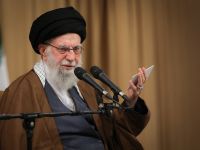Dr. Gil Feiler
The Israeli strike on Iranian territory last night represents a sharp escalation in the regional confrontation between Tehran and Jerusalem. Conducted with precision and likely aided by deep intelligence penetration, the operation targeted sensitive Iranian military infrastructure, including possible nuclear and missile development sites.
Israel’s ability to strike so effectively—despite Iranian defenses—highlights not only its superior military and technological prowess, but also Iran’s increasingly exposed strategic position. Tehran now faces a crucial question: how to respond forcefully without plunging into a war it cannot afford?
This question is particularly complex given the current geopolitical reality. Hezbollah, Iran’s most powerful proxy, is in deep decline. More significantly, Syria has ceased to function as a coherent state, and Bashar al-Assad is no longer in power. The loss of Damascus as a transit hub and staging ground strips Iran of a vital component of its regional strategy.
Iran’s options—military, economic, and diplomatic—are all still in play, but they are narrower and more fragmented.
Last night’s operation is the latest testament to Israel’s unmatched capabilities in the region. The IDF’s air force, bolstered by stealth aircraft such as the F-35I Adir, executed a deep-penetration strike with surgical accuracy. Reports suggest the strike included electronic warfare to disable radar systems, and perhaps cyber tools to blind or delay Iran’s ability to respond.
What makes Israel especially formidable is not only its firepower, but its integration of real-time intelligence, air dominance, and cyber warfare. Israeli intelligence agencies—Mossad, Aman, and Shin Bet—have repeatedly proven their reach inside Iran’s most secure facilities.
In addition, Israel’s multi-layered missile defense systems—Iron Dome, David’s Sling, Arrow 2 and 3—give it a strong buffer against both short-range rockets and long-range ballistic threats. Iran’s ability to inflict real damage in return is limited by this technological shield.
The success of the strike sends a clear message: Israel can project power beyond its borders and degrade adversaries’ capabilities without becoming bogged down in prolonged operations.
Iran’s Military Response: Asymmetric, Not Strategic
In the past, Iran has relied heavily on asymmetric warfare to counter Israel’s advantages. But that playbook has weakened considerably.
Iran possesses a large and increasingly accurate missile arsenal, including medium-range ballistic missiles such as the Shahab-3 and Emad. However, launching a direct strike on Israeli territory risks triggering massive retaliation, possibly even targeting core regime infrastructure.
Given the balance of power, such a move would be politically suicidal. Iran might fire a symbolic volley of missiles to save face domestically, but it would likely avoid hitting populated areas or strategic sites.
Hezbollah: Too Weak to Act
Tehran’s traditional deterrent—Hezbollah—is not in a position to help. The group has been weakened militarily by years of regional entanglement, stretched thin by Lebanon’s devastating economic collapse, and politically cornered by growing internal opposition.
Hezbollah’s leadership knows that a war with Israel now would be catastrophic. Israel’s northern defenses are stronger than ever, and any major offensive by Hezbollah would invite overwhelming retaliation. Limited rocket fire or border provocations are possible, but Hezbollah is unlikely to engage meaningfully.
Syria Is No Longer a Theater
With Assad deposed and Syria fractured into zones controlled by various militias, jihadist groups, and foreign powers, Iran has effectively lost its logistical backbone for regional operations. The once-vital land bridge—from Iran through Iraq and Syria to Lebanon—is now broken.
Without control in Damascus, Iran cannot reliably move weapons, personnel, or supplies to Hezbollah or other militias. Air corridors are routinely targeted by Israeli strikes, and no central Syrian authority exists to shield Iranian movements. This means Iran’s conventional and proxy strategies in the Levant are severely hamstrung.
Iraqi and Yemen-Based Militias: Secondary Options
Iran may look to smaller proxies in Iraq and Yemen, such as Kata’ib Hezbollah or the Houthis, to stage limited attacks on U.S. or Israeli-linked interests. These could include drone attacks on Gulf targets, rocket fire on U.S. bases, or maritime harassment in the Red Sea.
However, these actions are geographically and strategically distant from the Israeli-Iranian core conflict. They may irritate or distract, but they do not meaningfully restore deterrence.
Cyber Warfare: The Most Likely Tool
The most viable military response may come in cyberspace. Iran’s IRGC-linked cyber units have shown the ability to disrupt foreign infrastructure, including oil facilities and banks. Iran could target Israeli civilian systems—transport, water, finance—in the coming days.
Such attacks are deniable, difficult to attribute, and politically useful. Though not equal in sophistication to Israel’s cyber capabilities, Iran’s cyber forces are persistent and unpredictable.
Economic and Diplomatic Responses: Subtle But Calculated
With military options constrained, Iran is likely to engage in economic maneuvering and diplomatic escalation to recast the narrative and apply pressure
While Iran’s ability to influence global oil prices is limited under sanctions, it can still affect sentiment. By threatening shipping in the Strait of Hormuz or hinting at Gulf instability, Iran can rattle markets, prompting price spikes. Even a few “mysterious incidents” involving tankers could send a global signal.
Tehran may not want to close the Strait, but a few drone attacks or sabotage operations could create sufficient uncertainties
The Iranian regime will exploit the Israeli strike to shore up domestic legitimacy. The Revolutionary Guard will frame the attack as Zionist aggression backed by the West, using it to call for unity and “resistance.”
Iran will launch a diplomatic campaign to portray Israel as an aggressor and shift global attention to civilian risks and regional destabilization. It will push for emergency sessions at the UN and work through forums like the Non-Aligned Movement and the Organization of Islamic Cooperation (OIC).
China and Russia, though not military allies, may offer diplomatic cover—criticizing Israel’s actions and urging restraint—while maintaining their own strategic distance.
Strategic Forecast: A Slow-Burning Retaliation
With its alliance structure degraded, Iran will likely pursue a low-intensity, long-duration strategy rather than an immediate kinetic response. The Islamic Republic’s modus operandi is patience: leveraging time, narrative, and asymmetric tools to recover strategic ground.
We can expect the following:
- Cyberattacks against Israeli civilian infrastructure in the next week or two.
- Symbolic missile launches or minor proxy operations designed for Iranian domestic consumption.
- Maritime disruptions in the Gulf and Red Sea to send signals to international stakeholders.
Diplomatic escalation, particularly in the UN and Global South, to isolate Israel politically.
Rather than a dramatic act of vengeance, Iran’s response is likely to be fragmented, slow, and psychologically aimed at projecting endurance and legitimacy in the face of military inferiority.
Israel’s successful strike has underscored not just its military superiority, but Iran’s deep strategic isolation. With Assad gone from Syria, the Levant is no longer a theater for Iranian influence. With Hezbollah paralyzed, Iran’s regional deterrent is hollow. And with international sympathy limited, Tehran stands exposed.
Still, Iran is unlikely to concede defeat. Its response will be measured, indirect, and drawn out—designed to signal resilience, maintain internal stability, and extract long-term costs from its adversaries through asymmetric and diplomatic means.
But make no mistake: this was a strategic setback for Tehran. Its enemies are operating freely within its borders, while its allies can no longer hold the line.









